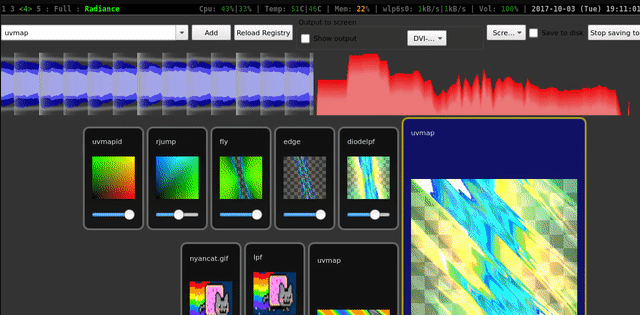Radiance is video art software for VJs. It supports beat detection, animated GIFs, YouTube video, OpenGL shader effects. It is designed for live performance and runs on Linux and MacOS.
Shader Effects
Radiance generates video from a set of connected "VideoNodes." Most commonly, these nodes are based on OpenGL fragment shaders, but can also be static images, GIFs, or videos. Each node takes one or more inputs and produces exactly one output.
Each OpenGL fragment shader node is described by a single .glsl file in resources/library/effects.
For the most part, these files are plain GLSL describing the fragment shader. This is similar to setups on shadertoy.com or glslsandbox.com . Each shader defines a function void main(void) which sets a pixel color vec4 fragColor for a given coordinate vec2 uv. fragColor is an RGBA color with pre-multiplied alpha: so white with 40% opacity is encoded as vec4(0.4, 0.4, 0.4, 0.4). The coodinate uv has x and y values in the range [0.0, 1.0] with vec2(0., 0.) corresponding to the lower-left corner.
The shader also has access to its input(s) as textures through the iInput (or iInputs[]) uniforms.
In addition, each shader has access to additional uniforms which are documented in resources/effects/*.glsl. The most important is iIntensity, which is a value in the range [0.0, 1.0] which is mapped to a slider in the UI that the user controls. There is a limitation of having exactly one input slider per effect: this is intentional to reduce the cognitive overhead on the end user. Other variables include information about the current audio or time.
Invariants
Each shader must follow these properties:
The fragColor set by each shader must be a valid, pre-multiplied alpha, RGBA tuple. Each component of the vec4 must be in the range [0.0, 1.0], and the RGB components must be less than or equal to the A component. (See afixhighlight for a shader that will highlight errors here in pink)
Identity: the shader must pass through its first input completely unchanged when iIntensity == 0. This means that inserting a new shader should not affect the output until its intensity is increased.
Multi-buffer Shader Effects
Some effects cannot be accomplished with a single fragment shader pass. An effect can consist of a series of shaders, separated by #buffershader. Each shader renders to a texture in iChannels. The shaders are rendered in backwards-order, so the last shader in the file is rendered first. Only the output of the first shader in the file is displayed -- the other buffers persist between frames but are not exposed to other nodes.
An example that uses this feature is foh.glsl. This implements an (exponential) "first-order hold" - it samples the input texture on a multiple of the beat and stores it in iChannel[1].






Discussion (0)